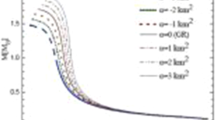Abstract
We present the results of a systematic study of the dynamics of realistic binary systems in the post-Newtonian approximation (PNA) of general relativity. We propose definitions valid in the PNA for the self-angular-momenta of the binary's members, as well as for the angular momentum of their relative orbital motion, and we examine under which conditions they can be considered as constant in the PNA. This enables us to define to the same approximation the plane relative orbital motion. Then we find the form of the differential equations of motion from an integration of which we prove that in the PNA the relative motion is a processing ellipse composed of a basic orbit and a correction, both of which are of post-Newtonian character. Moreover, using the polar equation of the above ellipse we define the elements of the post-Newtonian, relative, basic orbit, we generalize to the PNA the three well-known laws of classical celestial mechanics of Kepler, and we derive the precessional motion of the relative orbit's pericenter. Finally, we compare our method with other methods existing in the literature, and we expose its theoretical and conceptual differences with them.
Similar content being viewed by others
References
Spyrou, N. (1979). Relativistic dynamical description of binary stars, Habilitation thesis, University of Thessaloniki, Greece.
Spyrou, N. (1977a).Gen. Rel. Grav.,8, 463 (paper I).
Spyrou, N. (1977b).Gen. Rel. Grav.,8, 491 (paper II).
Spyrou, N. (1978a).Gen. Rel. Grav.,9, 519 (paper III).
Robertson, H. P. (1938).Ann. Math.,39, 101.
Einstein, A., Infeld, L., and Hoffmann, B. (1938).Ann. Math.,39, 65.
Contopoulos, G., and Spyrou, N. (1976).Astrophys. J.,205, 592.
Spyrou, N. (1978b).Celestial Mech.,18, 351.
Adler, R., Bazin, M., and Schiffer, M. (1965).Introduction to General Relativity, McGraw-Hill Book Company, New York.
Wagoner, R. V., and Will, C. M. (1976).Astrophys. J.,210, 764 (paper IV).
O'Brien, G. (1979).Gen. Rel. Grav.,10, 129.
Synge, J. L. (1970).Proc. R. Ir. Acad. Sec. A.,69, 11.
Caporali, A. (1979). An approximation method for the determination of the motion of extended bodies in general relativity, Ph.D. thesis, University of Munich, West Germany.
Ehlers, J. (1972). InProceedings of the International School of General Relativistic Effects in Physics and Astrophysics. Experiments and Theory (3rd Course), ed. J. Ehlers, MPI Föhringer Ring 6, D 8 München 40.
Caporali, A., and Spyrou, N. (1979).Gen. Rel. Grav., to be published.
Epstein, R. (1977).Astrophys. J.,216, 92.
Taylor, J. H., Fowler, L. A., and McCulloch, P. M. (1979).Nature,277, 437.
Author information
Authors and Affiliations
Rights and permissions
About this article
Cite this article
Spyrou, N. Relativistic celestial mechanics of binary stars. Gen Relat Gravit 13, 473–485 (1981). https://doi.org/10.1007/BF00756595
Received:
Issue Date:
DOI: https://doi.org/10.1007/BF00756595




